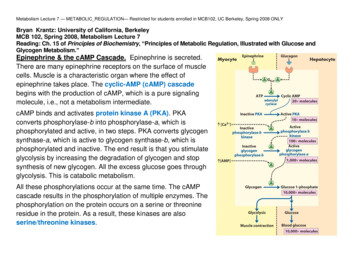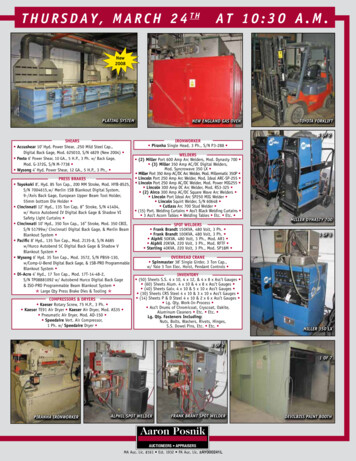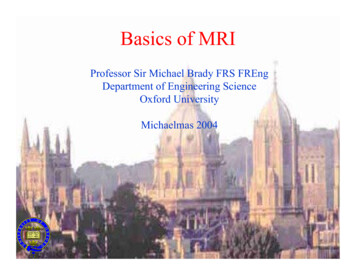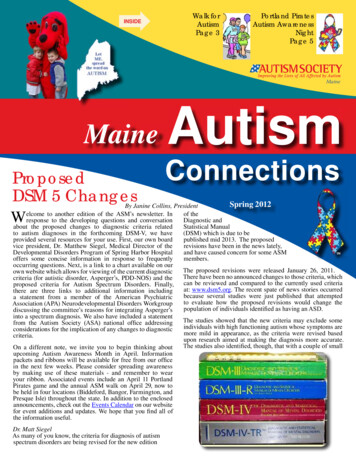
Transcription
Metabolism Lecture 7 — METABOLIC REGULATION— Restricted for students enrolled in MCB102, UC Berkeley, Spring 2008 ONLYBryan Krantz: University of California, BerkeleyMCB 102, Spring 2008, Metabolism Lecture 7Reading: Ch. 15 of Principles of Biochemistry, “Principles of Metabolic Regulation, Illustrated with Glucose andGlycogen Metabolism.”Epinephrine & the cAMP Cascade. Epinephrine is secreted.There are many epinephrine receptors on the surface of musclecells. Muscle is a characteristic organ where the effect ofepinephrine takes place. The cyclic-AMP (cAMP) cascadebegins with the production of cAMP, which is a pure signalingmolecule, i.e., not a metabolism intermediate.cAMP binds and activates protein kinase A (PKA). PKAconverts phosphorylase-b into phosphorylase-a, which isphosphorylated and active, in two steps. PKA converts glycogensynthase-a, which is active to glycogen synthase-b, which isphosphorylated and inactive. The end result is that you stimulateglycolysis by increasing the degradation of glycogen and stopsynthesis of new glycogen. All the excess glucose goes throughglycolysis. This is catabolic metabolism.All these phosphorylations occur at the same time. The cAMPcascade results in the phosphorylation of multiple enzymes. Thephosphorylation on the protein occurs on a serine or threonineresidue in the protein. As a result, these kinases are alsoserine/threonine kinases.
Metabolism Lecture 7 — METABOLIC REGULATION— Restricted for students enrolled in MCB102, UC Berkeley, Spring 2008 ONLYAmplification. You do this in many steps to amplify the effect. You come in with one signal molecule ofepinephrine, which will activate the receptor. The receptor will activate many G-proteins. Each of these Gproteins will activate adenylylate cyclase. cAMP will activate many PKA enzymes. At every step, there willbe many-fold amplification. One single hormone molecule activate hundreds of phosphorylationsUnlike allosteric regulation, you produce a ―permanent‖ change in the enzyme molecule, so the effect can belasting.Reciprocal Regulation. The reversal of the enzyme phosphorylation modification may require either akinase or a phosphatase enzyme and these are regulated in a reciprocal fashion.
Metabolism Lecture 7 — METABOLIC REGULATION— Restricted for students enrolled in MCB102, UC Berkeley, Spring 2008 ONLYRegulation of Glucose Homeostasis under Normal ConditionsRegulation vs. Control. These are two terms for specific situations.Metabolic regulation — maintaining [metabolite]; homeostasis.Metabolic control — in response to stimulus the output through the metabolic pathway isaltered“Fight or Flight”. Brain senses danger; muscles prepare to run.Hypoglycemia. What happens when the blood sugar is too low? Mental impairment, impairedjudgement, nonspecific dysphoria, anxiety, moodiness, depression, crying, negativism, irritability,belligerence, combativeness, rage, personality change, emotional lability, fatigue, weakness, apathy,lethargy, daydreaming, sleep, confusion, amnesia, dizziness, delirium, headaches, seizures, andeventually coma. The brain is very affected; and this is very bad.Diabetes. What happens when the blood glucose level is too high? Recall C1 of glucose is analdehyde. It is a reactive and produces an addition compound with proteins; glucose adducts ofhemoglobin that can be quantified in a laboratory test. Obviously glucose-modified proteins are not agood thing and diseases, which cannot regulate [glucose] in the blood can be harmful if not managed.To assess whether there is diabetes, a doctor can test for the amount of glucose after fasting.Doctors also want to know what the average level of glucose is in your blood stream while you arecarrying on daily chores. The amount of glucose-modified hemoglobin is a very good indicator.Homeostasis of Blood [Glucose]. Goldy Locks says, ―The glucose concentration is just right!‖Glucose levels should be in the range of 4 to 8 mM.
Metabolism Lecture 7 — METABOLIC REGULATION— Restricted for students enrolled in MCB102, UC Berkeley, Spring 2008 ONLYGlucagon. Low blood glucose levels can also be catastrophic, because your brain can only reallyutilize only glucose. (It can utilize ketone bodies in a crisis.) The brain requires a constant supply ofglucose, else it will stop functioning and confusion will set in.The pancreas senses low blood glucose levels andreleases glucagon, a polypeptide hormone, into theblood. Glucagon mostly affects the liver because livercells have a large number of glucagon receptors. Bychanging the number of receptors, you can produceorgan-specific regulation.Glucagon receptor cAMP cascade Phosphorylation reactions Glycogen breakdownGlycogen via phosphorylase Glucose 1-phosphate Glucose 6- phosphateFor muscle, the glucose-6-phosphate goes into glycolysis and will generate energy.For liver, the degradation of glucose-6-phosphate through the glycolytic pathway is inhibited. Glucose6-phosphate accumulates. The liver hydrolyzes glucose-6-phosphate into free glucose, which is thenreleased into the bloodstream for other organs, like the brain.
Metabolism Lecture 7 — METABOLIC REGULATION— Restricted for students enrolled in MCB102, UC Berkeley, Spring 2008 ONLYGlycolysis Regulation. How does glycolysis become inhibited? By thecAMP cascade, many enzymes get phosphorylated, including a liver enzymethat makes yet another signaling molecule, called Fructose 2,6bisphosphate. This is a signaling molecule, unique from fructose 1,6bisphosphate—a direct metabolite of glycolysis and gluconeogenesis.Phosphofructokinase-2. PFK-2 is like PFK-1 except catalyzes this phosphoryl transfer reaction.Fructose 6-phosphate ATP Fructose 2,6-bisphosphate ADPThis enzyme occurs in the same large polypeptide chain with an enzyme that catalyzes the backwardreaction, Fructose bisphosphatase-2 (FBPase-2).Fructose 2,6-bisphosphate Fructose 6-phosphate PiThis regulatory enzyme contains two distinct enzyme activities in two active sites on one singlepolypeptide chain.FPK-2 gets phosphorylated in the cAMP cascade in the liver. The effect of phosphorylationgenerally depends on the enzyme, but usually activity either goes up or down. When this giantenzyme gets phosphorylated, PFK-2 activity goes down and FBPase-2 activity goes up. The endresult is that the concentration of fructose 2,6-bisphosphate goes down.
Metabolism Lecture 7 — METABOLIC REGULATION— Restricted for students enrolled in MCB102, UC Berkeley, Spring 2008 ONLYFructose 2,6-bisphosphate is the most powerful regulator of theactivity of PFK-1. We talked about how PFK-1 activity is regulated byATP and AMP. Fructose 2,6-bisphosphate is far more powerful thanAMP & ATP. When [fructose 2,6-bisphosphate] goes down, glycolysis isinhibited, and glucose enters into the blood.***Without fructose 2,6-bisphosphate in the liver, glycolysis cannot occur.***
Metabolism Lecture 7 — METABOLIC REGULATION— Restricted for students enrolled in MCB102, UC Berkeley, Spring 2008 ONLYHigh [Glucose]Hexokinase. Michaelis-Menton plots of the velocity of thehexokinase reaction versus glucose concentration show thatmuscle and liver hexokinase differ in Kms.When you look at what happens with the liver hexokinase,you get a curve that is less steep. When you take thesubstrate concentration at half the maximal rate, then that isthe Km. The Km value in the liver is about 10mM. The affinityof the liver hexokinase (glucokinase) toward glucose is lowerwith the liver enzyme. The normal levels of blood glucose areclose to 5mM. It is much lower than the Km.Liver hexokinase can respond to changes in [glucose].When the substrate concentration is much lower than the Km, the reaction rate is almost proportionalto the concentration of substrate. When the glucose levels go up, the levels of phosphorylation ofglucose by the liver enzyme also go up, which allows the liver to take care of excess glucose. If youhave lots of glucose, then the liver enzyme will function much faster and take away glucose.Glucagon levels goes down in response to high [glucose]. The opposite regulation of the PFK2/FBPase-2 will occur. The enzyme will become dephosphorylated, which results in the activation ofthe PFK-2 activity. You will now have much more fructose-2,6-bisphosphate. The glucose-6phosphate that your liver glucokinase generated by using the extracellular glucose in the bloodstreamwill go down rapidly through the glycolytic pathway. At the end of glycolysis, most of the product willbe converted to fat.
Metabolism Lecture 7 — METABOLIC REGULATION— Restricted for students enrolled in MCB102, UC Berkeley, Spring 2008 ONLYInsulin response to high [glucose]. The secretion of the proteinhormone, insulin, from the pancreas occurs. It goes through totallydifferent regulatory pathways in the liver cell. The insulin receptor getsstimulated, and that causes a decreased uptake of glucose by manydifferent cells in the body.Insulin affects glucose uptake and metabolism. Signal transduction isemployed in the regulatory mechanism. Insulin binds to its receptor whichin turn starts protein activation cascades. These include: translocation ofGLUT-4 transporter to the plasma membrane and influx of glucose, glycogen synthesis, glycolysis,and fatty acid biosynthesis in fat storing cells, adipocytes.
Metabolism Lecture 7 — METABOLIC REGULATION— Restricted for students enrolled in MCB102, UC Berkeley, Spring 2008 ONLY
Metabolism Lecture 7 — METABOLIC REGULATION— Restricted for students enrolled in MCB102, UC Berkeley, Spring 2008 ONLYCITRIC ACID CYCLEMitochondria. The citric acid cycle (CAC or TCA cycle) occursin mitochondria, not in the cytosol. Mitochondria—thepowerhouses of the cell—are likely descendants of ancestralbacteria. A mitochondrion has its own circular DNA, ribosomes,and does cell division! Mitochondria have two membranes, likemost Gram negative bacteria, the outer and inner membranes.The inner membrane folds to create cristae, increasing surfacearea for enzymes involved in the electron transport chain. Theinternal space is the mitochondrial matrix, where CAC occurs.Cellular respiration. Aerobic catabolism takes place in mitochondria.Glucose O2 CO2 H2O Work HeatOxidation. Why does all the metabolism of citric acid cycle and oxidative phosphorylation take placein the mitochondria? We are now getting into oxidative metabolism. Oxidation is a dangerous processthat generates a number of highly reactive molecules. If you want to reduce a molecule of oxygen, itwill eventually become water.To reduce oxygen, you have to add electrons one by one. Some of the intermediates are verydangerous, like super-oxide (O2-). O2- is a reactive species that destroys biomolecules. Thus theconfined space in the matrix of the mitochondria is a way to keep the bad guys contained.
Metabolism Lecture 7 — METABOLIC REGULATION— Restricted for students enrolled in MCB102, UC Berkeley, Spring 2008 ONLYHistory of the TCA Cycle DiscoveryDicarboxylic Acid Cycle. The notion of the citric acid cycle was originated in the observations of aman called Sgent-Gyöngy. He was studying the oxidation carried out by minced pigeon muscle. Hewas interested in what happens when you added dicarboxylic acid. He added fumarate into thisoxidizing pigeon muscle preparation. He could calculate that if fumarate became oxidized completelyinto CO2 and H2O, then the use of one micromole of fumarate results in the consumption of threemicromoles of oxygen. When he experimentally added a small amount of fumarate, this resulted inthe increase in the oxygen consumption of 23.6 micromoles of oxygen. He came up with the idea thatthese dicarboxylic acids could be working as catalysts in the oxidation of other molecules.Tricarboxylic Acid Cycle. Hans Krebs has changed this idea. He decidedthat this is a tricarboxylic acid cycle. The intermediates of the citric acid cycleact as true intermediates and not as catalysts.
Metabolism Lecture 7 — METABOLIC REGULATION— Restricted for students enrolled in MCB102, UC Berkeley, Spring 2008 ONLYPhases of the TCA Cycle.[1] Acetyl-CoA production: Organic fuels Acetyl-CoA[2] Acetyl-CoA oxidation: Acetyl-CoA enters TCA and is enzymatically oxidized, but energy isconserved in electron carriers, NADH FADH2[3] Electron transfer: energy rich e- in NADH FADH2 reduce O2 to H2O
Metabolism Lecture 7 — METABOLIC REGULATION— Restricted for students enrolled in MCB102, UC Berkeley, Spring 2008 ONLYPyruvate is converted to Acetyl-CoAThe first reaction before you enter the TCA cycle isthe conversion of pyruvate into the two carbonintermediate that is necessary for entry into thecycle, acetyl-CoA–an acetate attached toCoenzyme A (CoA).Pyruvate NAD CoA Acetyl-CoA NADH CO2Energetics. ΔGº’ –33 kJ/mol, and it is a strongly downhill reaction.Pyruvate Dehydrogenase. Many coenzymes and co-factors. The enzyme is called pyruvatedehydrogenase and is complicated. The simplest pyruvate dehydrogenase enzyme in E. colicontains 60 subunits! These subunits are composed into three different types: E1, E2 and E3.
Metabolism Lecture 7 — METABOLIC REGULATION— Restricted for students enrolled in MCB102, UC Berkeley, Spring 2008 ONLY
Metabolism Lecture 7 — METABOLIC REGULATION— Restricted for students enrolled in MCB102, UC Berkeley, Spring 2008 ONLYThiazolium ring. E1 uses another coenzyme thatis called thiamine pyrophosphate (TPP) fromvitamin B1. You have a quaternary nitrogen here,which we discussed with aldolase. It is a powerfulelectron sink. This proton next door on the carbonatom becomes easily released as a protonbecause of this electron sink. You generate acarbanion. The carbanion attacks the electronpoor carbonyl carbon of pyruvic acid. Now that wehave made this addition compound with thisquaternary nitrogen in close contact with thiscarbanion, the decarboxylation of pyruvatebecomes very easy.When you take a look at the aldolase mechanism,it is very similar. With aldolase, we have aprotonated imine nitrogen and you broke acarbon-carbon bond two carbons away. When youwant to break this carbon-carbon bond inpyruvate, you want to have an electronwithdrawing group two carbon atoms away. You use this thiazolium group of TPP to generate asituation where you have this electron withdrawing power. This is similar to aldolase.After decarboxylation and the addition of the proton, you get hydroxy-ethyl TPP. This reaction is likethat for the decarboxylation of pyruvate to acetaldehyde.
Metabolism Lecture 7 — METABOLIC REGULATION— Restricted for students enrolled in MCB102, UC Berkeley, Spring 2008 ONLY
Metabolism Lecture 7 — METABOLIC REGULATION— Restricted for students enrolled in MCB102, UC Berkeley, Spring 2008 ONLYLipoic acid. After the generation of this hydroxy-ethyl TPP intermediate, you can abstract the protonto get a carbanion on the central carbon of pyruvate. You come in with a coenzyme on E2 that has adisulfide group, lipoic acid. It has a disulfide bond that is bound to the lysine epsilon amino group inthe enzyme.When the lipoic acid occurs at the amideof the epsilon amine group of a lysineresidue in the protein, it is calledlipoamide. The important part of lipoicacid is the disulfide bond. This carbanionattacks one of the sulfur groups. This is areduction, which is unusual becausethere is no oxygen involved. You areadding an electron pair. Two electronsare involved here. Lipoamide becomesdihydrolipoamide. It becomes reduced.What used to be the pyruvate moietynow becomes covalently bound to one ofthe sulfur atoms. Later, there is therelease of an acetyl group that isgenerated by acetyl-dihydrolipoamide.
Doctors also want to know what the average level of glucose is in your blood stream while you are carrying on daily chores. The amount of glucose-modified hemoglobin is a very good indicator. Homeostasis of Blood [Glucose]. Goldy Locks says, ―The glucose concentration is just rig










